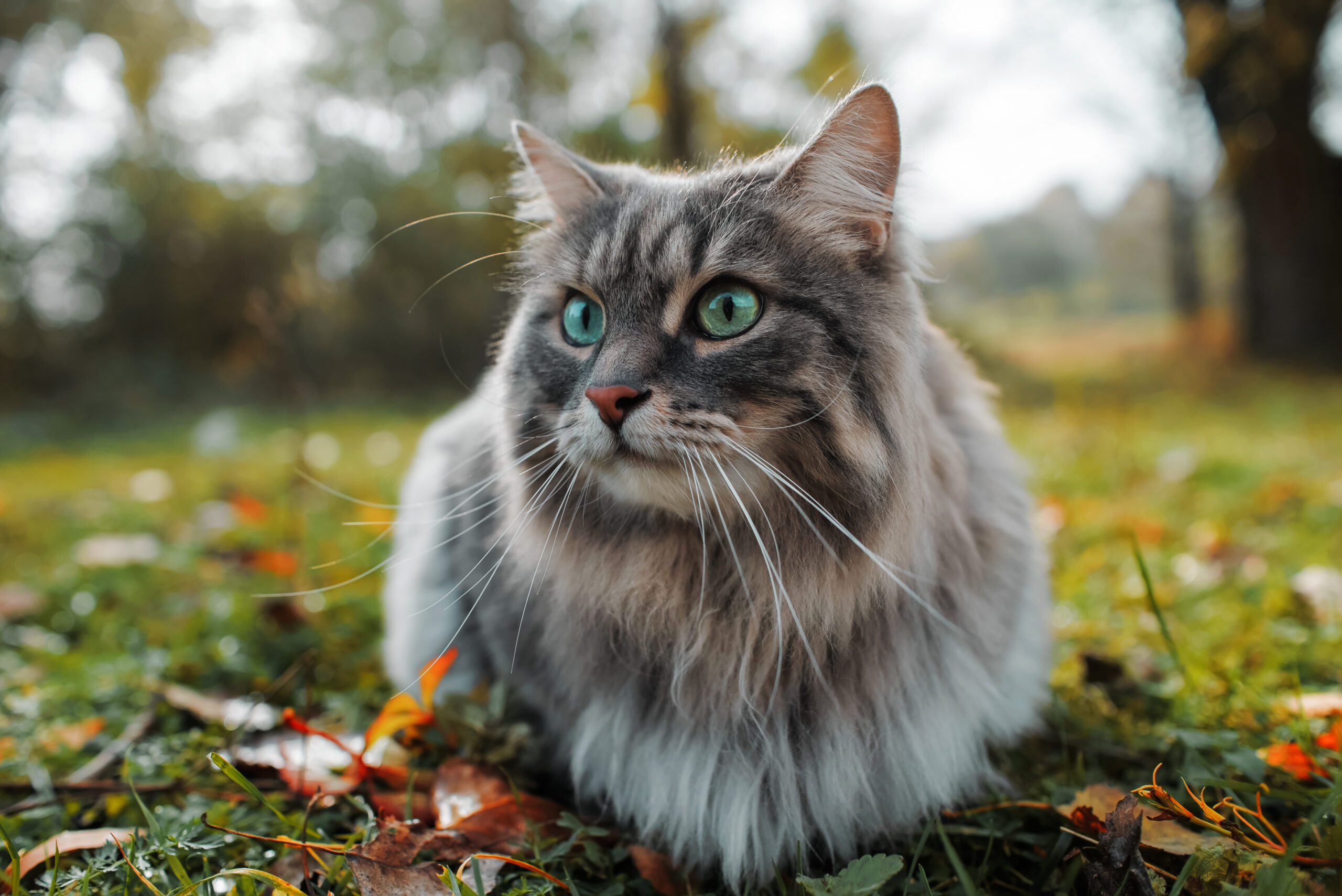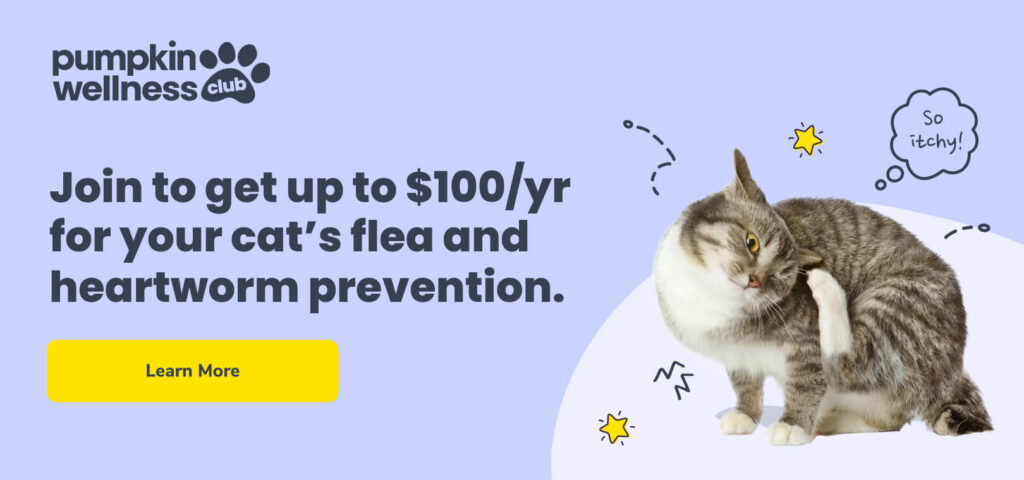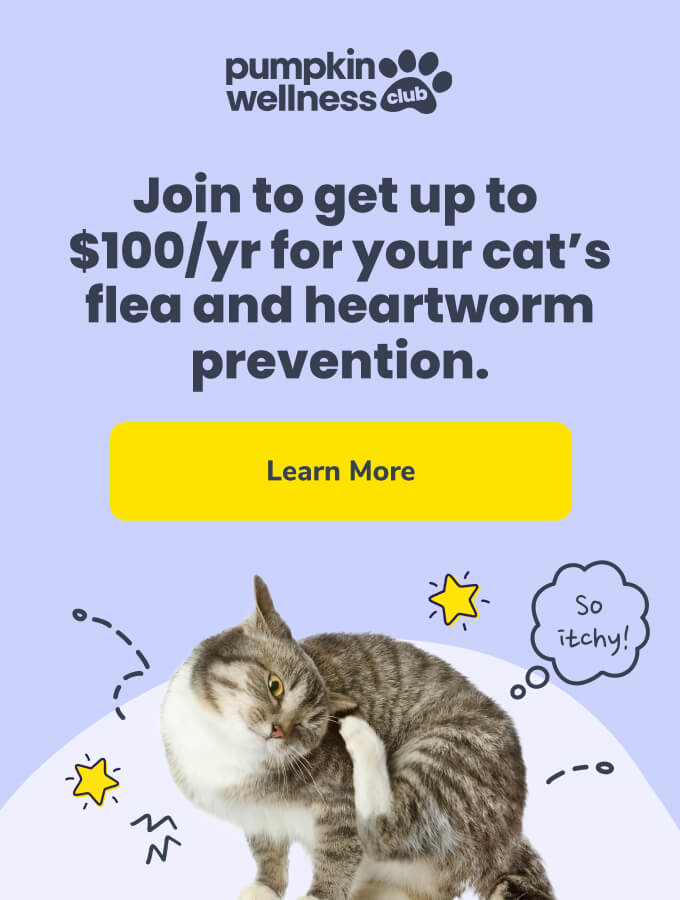Key Points
- Cats can get fleas, but infestations are more common in cats that spend time outdoors and in multi-pet households.
- Fleas can cause itchiness, skin irritation, excessive scratching, and hair loss in cats.
- Luckily, you can help prevent flea infestations with regular grooming, cleaning your home, and preventive medications.
- Get paid up to $100/yr for your cat’s flea preventives and save big on other routine care services and cat-friendly perks by joining the Pumpkin Wellness Club.*
Cats love to scratch, whether they’re rubbing themselves against the edges of furniture or contorting into a yoga pose to itch behind their ears. It’s perfectly normal for cats to scratch themselves or even nibble at itchy areas, but too much of this behavior can indicate a flea problem.
It’s a nightmare for any pet owner, but unfortunately cats are not immune to fleas. These little parasites can make a home on your furry friend, suck their blood, transmit even tinier parasites, and cause intense itching and skin irritation for some cats. As a cat parent, it’s important that you know the telltale signs of a flea infestation, as well as how to prevent and treat it.
Let’s dive into the world of flea prevention and treatment for cats.
How cats get fleas
Fleas are tiny, parasitic insects that infest cats, dogs, and other furry mammals. Some fleas will also feed on birds, but we’ll focus on four-legged pets in this article.
Cats are ideal hosts for fleas due to their fur, which provides a warm and cozy environment for these pests to thrive. Additionally, cats often groom themselves, which can help fleas spread from one part of their body to another.
A flea infestation can cause discomfort, irritation, and even serious health problems for your cat. These blood-sucking pests can easily jump from one animal to another, potentially contributing to the spread of disease or causing multiple pets to become infested. They will even bite humans, so a flea infestation can be a pain for the entire household.
Fleas in cats vs. dogs
Due to their fastidious grooming habits, cats are generally considered to be less prone to flea infestations than dogs. Dogs tend to spend more time outdoors, where they can encounter parasites in the grass or on other animals. However, outdoor cats and those that interact with other animals can still be affected.
If your cat enjoys venturing outside or cuddling with your active Labrador, they may have a greater chance of coming into contact with fleas. A few other factors can influence the likelihood of a flea infestation in your cat or dog:
- Outdoor exposure: Cats that spend significant time outdoors are more likely to encounter fleas, as these parasites thrive in grassy areas and other outdoor environments.
- Regional climate: You live in an area that has hot, humid weather during all or part of the year.
- Contact with other animals: Cats and dogs that come into contact with other animals, such as stray cats or dogs, are at a higher risk of getting fleas. This also applies if you have a lot of wildlife in your area.
- Living arrangements: Cats and dogs living in multi-pet households or those that share living spaces with other animals may be more susceptible to flea infestations.
- Grooming habits: Cats and dogs with long or thick coats may provide a more suitable environment for fleas to hide and reproduce.
- Regional climate: You live in an area that has hot, humid weather during all or part of the year.
Additionally, cats may be less likely to show obvious signs of fleas, making it more difficult to detect an infestation. Cats are frequent self-groomers, so they may ingest the evidence (live fleas and flea dirt) while licking themselves for relief.
Signs of fleas in cats
Several signs can indicate a flea infestation on your cat, including:
- Excessive scratching
- Hair loss
- Skin irritation
- Flea dirt
- Restlessness
While it’s normal for cats to scratch themselves, a cat infested with fleas will scratch more frequently and may lose patches of hair as a result. Look out for hair loss around the tail and rear, as well as any redness, bumps, or scabs on your cat’s skin.
You may also notice small, black specks in your cat’s coat — known as “flea dirt” — which is actually flea poop. However, cats may accidentally ingest these specks while grooming, so a lack of flea dirt doesn’t mean your cat is definitely flea-free. You should still keep an eye on your cat’s behavior and see your vet if your cat seems unusually restless, irritable, or itchy.
Finally, you may spot the fleas themselves. These small insects can often be spotted near your cat’s ears, nose, and eyes. Look out for bugs that are black, wingless, and are about the size of the head of a pin. They have long legs, and can crawl and jump very well.
Pet Pro Tip: The Pumpkin Wellness Club can help you save on your cat’s preventive care at the vet, and one membership option will even pay you up to $100 for prescription flea, tick, and heartworm prevention each year. You can also get paid for annual wellness visits, vaccinations, fecal testing, and other routine services your cat needs to stay healthy.
Preventing fleas in cats
Preventing fleas is crucial to maintaining your cat’s health and comfort. While dog owners might be more used to seeking out pest preventatives, cat owners should also discuss flea prevention methods at their annual vet visit.
Consult with your veterinarian to discuss flea prevention products, which can include topical treatments, oral medications, or flea collars. Remember that pets can pass fleas to each other and to you! All cats, dogs, and ferrets in your household should be on flea control either year round or seasonally, depending on your weather.
Other flea prevention methods include:
- Every couple of days: Brush your cat’s fur and look for fleas or flea dirt
- At least once a week: Clean your home environment, including vacuuming all rugs and floors to remove any fleas, eggs, or larvae. Flip cushions and vacuum nooks and crannies where fleas love to hide.
- Wash your cat’s toys and bedding weekly.
- Clean up leaf litter in your yard or any places where fleas could hide (think cool and dark spots).
- Apply pet-safe flea treatment to your home and yard.
Treating a flea infestation in your cat
If you suspect your cat has fleas, it’s important to seek veterinary advice for proper treatment. Your veterinarian can recommend appropriate flea medication and guide you through the immediate next steps.
Similar to prevention options, flea treatments are commonly available as oral or topical medication. If your cat isn’t a fan of taking pills, the vet may recommend a topical option that can be applied on your cat’s neck (where they can’t lick it off) and absorbed into their skin.
Additionally, some flea treatments work by killing adult fleas, while others stop juvenile fleas from maturing and reproducing — there are plenty of options to choose from, and your vet can help you choose the one that’s best for your cat.
Additional risks associated with cat fleas
Some cats may experience additional discomfort due to a reaction called flea allergy dermatitis. Flea saliva is an allergen for some cats, which can develop intense itching, hair loss, scabs, and skin infections from the bite of just one flea. If you notice these lesions on your cats, see your veterinarian as soon as possible. Strict, year round flea control for these cats (and their housemates) is recommended to prevent itching, hair loss, and discomfort.
In general, flea infestations can lead to anemia due to blood loss. Anemia occurs when a mammal has lost a significant amount of red blood cells, which may occur if a flea infestation is left untreated. Kittens and puppies are more susceptible to flea anemia, as they are smaller and have less blood to lose.
Fleas can also spread other parasites and bacteria via their bites. Adult fleas often carry tapeworms, which can end up in your cat’s digestive tract if they accidentally ingest fleas while grooming. Tapeworm segments, although disgusting, are white and look like a grain of rice. They can be found around your cat’s anus, in the litter box, or on their bedding.
Fleas can also transmit a bacteria known as Bartonella henslae, which not only causes disease in cats but can actually spread to humans via an infected cat’s scratch or saliva.
Preventing other common cat parasites
While fleas are a common concern for cat owners, it’s essential to protect your cat from other parasites, too. Ear mites can spread just as quickly as fleas in shelters or outdoor cat populations, so keep an eye out for dark residue around your new kitty’s ears. Outdoor cats also have a greater chance of coming into contact with ticks or heartworms in the wild — and if your cat is an amateur hunter, they can contract intestinal worms from infected mice or other prey.
Make sure you know about these other common intestinal worms and parasites that can make your cat sick, especially if your cat enjoys exploring the great outdoors:
Luckily, many medications that prevent flea infestations also protect against ear mites, ticks, intestinal invaders, and heartworm disease — so you can double or triple your cat’s protection with a single dose. Members of the Pumpkin Wellness Club can get paid up to $100 for these flea, tick, and heartworm preventive medications each year, along with hundreds more for other routine care that your cat gets at their annual wellness visit. Learn more about how you can save up to $390 annually on your cat’s wellness care and other perks, including discounts on top pet brands!
The final word on cat fleas
Fleas are a pain for both cats and their owners. By understanding the signs of a flea infestation, practicing effective prevention methods, and seeking veterinary advice and care when necessary, you can help keep your cat healthy and flea-free. Additionally, your cat may need protection from other parasites, such as heartworms and ticks, depending on their lifestyle.
Finally, if you do spot fleas on your cat, don’t panic! While these pests will send a shiver up your spine, they’re an unfortunate part of pet parenthood, and your kitty is counting on you to stop the itch.
DISCLOSURE





